15 Types of Black Birds in Montana (With Pictures)
Last Updated on
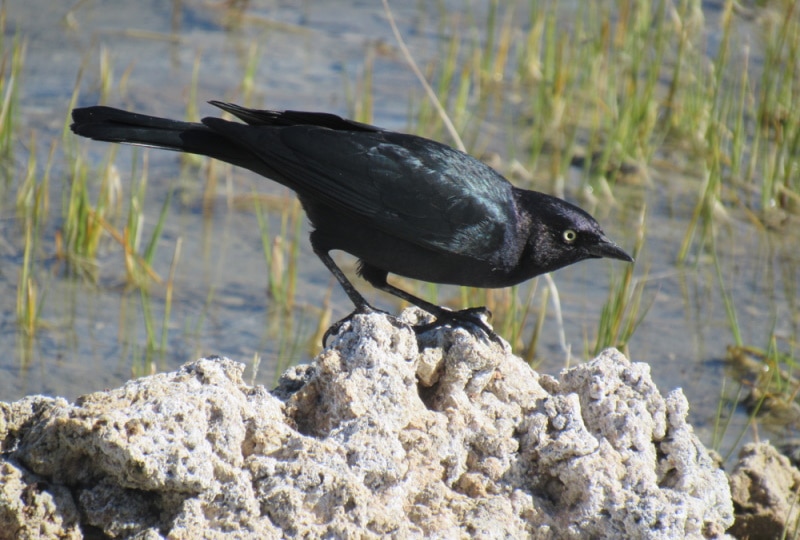
North America is home to 25 species of New World Blackbirds, and 15 of them are found in Montana. In this state, you’ll find a myriad of orioles, cowbirds, meadowlarks, bobolinks, blackbirds, and grackles.
Montana is an extremely cold region in the US, so most blackbirds migrate to this state in April to spend summer, which is the breeding season. Then, they leave for warmer regions, such as Costa Rica or Southern Canada, in November.
Twelve of the 15 blackbird species in Montana are spotted regularly, while the rest are accidental, rare, and near-threatened. Here are the 15 types of unique and beautiful blackbirds in Montana.

The 15 Types of Black Birds in Montana:
1. European Starling
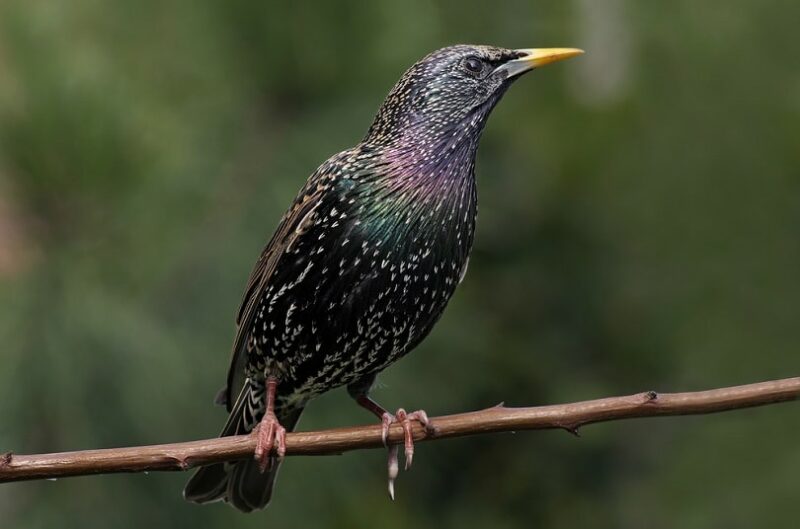
| Scientific Name | Sturnus vulgaris |
| Weight | 0.21 pounds |
| Wingspan | 15.8 inches |
| Lifespan | 3 years |
| Diet | Insects, berries, fruits, and seeds |
You can find the European Starling any time of the year in the deep woodlands, forested areas, and fields of Montana.
They have small bodies covered in black, iridescent, and white-edged feathers. The bird has a galaxy-like appearance due to the diverse shades of black, blue, and purple. They also have red feet, black tips, and yellow beaks.
European Starlings feed on insects, berries, fruits, and seeds. They prefer cherries, mulberries, holly berries, grains, and seeds. Regarding insects, they prefer flies, beetles, caterpillars, Virginia Creepers, spiders, earthworms, and sumac.
These birds don’t have their song and often mimic other birds’ songs. However, their calls are unique, consisting of whistles, warbles, and chatters.
2. Red-winged Blackbird
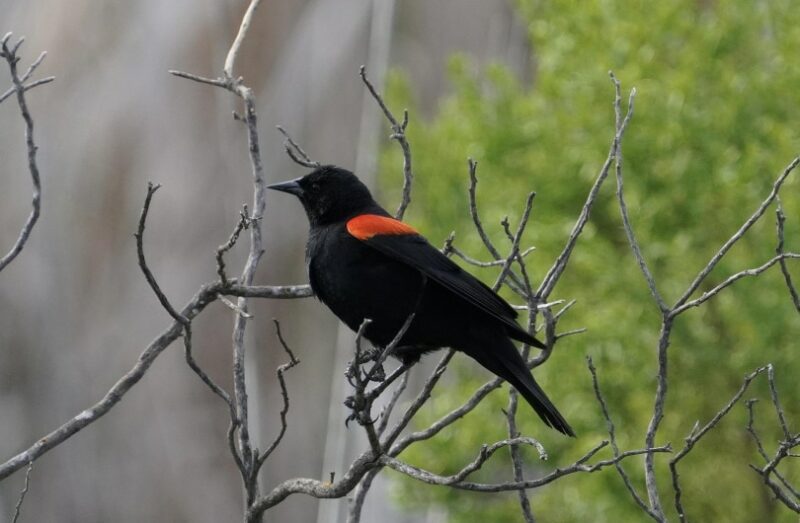
| Scientific Name | Agelaius phoeniceus |
| Weight | 0.16 pounds |
| Wingspan | 15.8 inches |
| Lifespan | 15 years |
| Diet | Seeds and suet |
Like most blackbirds, the Red-winged Blackbird spends its breeding season in colder regions such as New York and Montana. This unique bird is covered in black feathers with bright yellow and red patches on its shoulders.
They’re typically seen on telephone wires, meadows, fields, and marshes. While they’re in Montana, they prefer to feed on insects. However, their diet switches to seeds and suet in warmer regions.
Red-winged Blackbirds have unique calls and songs, identifiable due to the drawn-out ‘okelee’ sound.
These birds are known for their aggressive behavior, especially while nesting. This is when the male finds a territory, defends it relentlessly, and even attacks those that come near. Meanwhile, the female builds most of the nest with the help of stems and stalks.
3. Western Meadowlark
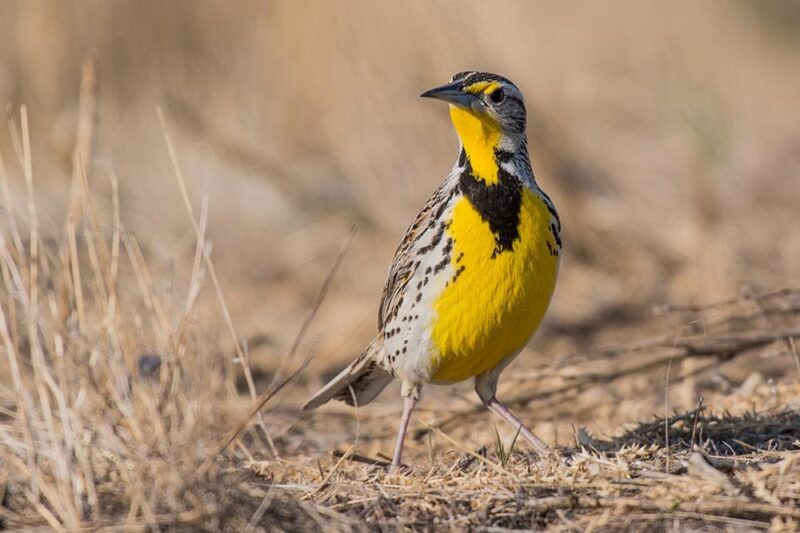
| Scientific Name | Sturnella neglecta |
| Weight | 0.25 pounds |
| Wingspan | 16.1 inches |
| Lifespan | 6 years |
| Diet | Insects and seeds |
Western Meadowlarks occur accidentally in Montana, found in deep woodlands, fields, grassy areas, shrubby vegetation, and meadows. Their feathers are black and brown, with a bright yellow underbelly and a unique black band across their chest. During the winter, this band turns gray.
The diet of a Western Meadowlark includes insects, seeds, and grain. You may find them building a nest in the depressions of grassy fields, which they fill with more grass for bedding and plant stalks for roofing.
You may identify these birds with their sweet and traditional calls, including a series of whistles, tweets, and warbles. Those that want a closer look can place cracked corn and sunflower seeds to attract Western Meadowlarks to their backyard.
4. Brown-headed Cowbird
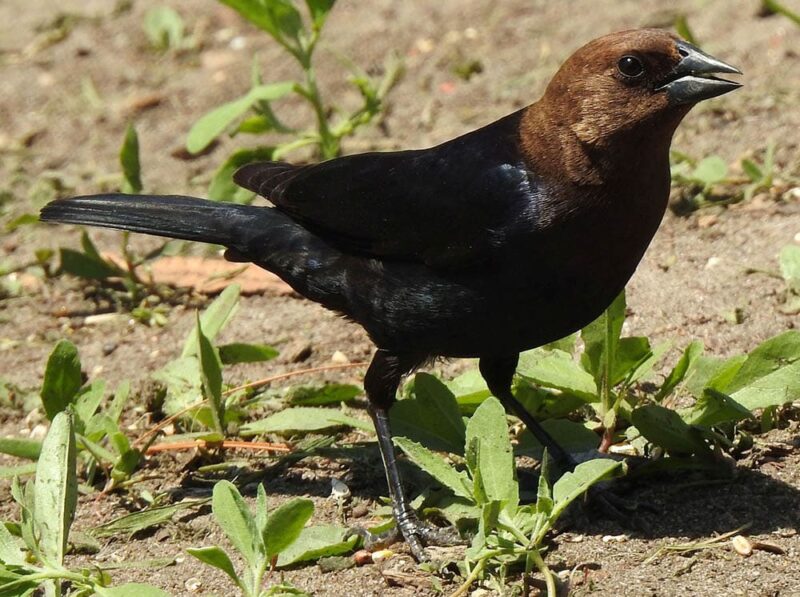
| Scientific Name | Molothrus ater |
| Weight | 0.11 pounds |
| Wingspan | 14.2 inches |
| Lifespan | 17 years |
| Diet | Seeds and insects |
Of course, the identifying feature of a Brown-headed Cowbird is none other than its brown head. Its round body is covered in black feathers and no other feature to set it apart from other Cowbirds. You’ll find these birds in the woodlands, grassy areas, and open fields of Montana.
Their diet mainly consists of weed seeds, grass, and insects. However, they aren’t picky and will eat any form of nutrition found in their habitat. You may even occasionally spot a female Brown-headed Cowbird feeding on an eggshell for some calcium.
Their sounds aren’t as rhythmic or melodic as other blackbirds on the list, but their disarrayed calls make them easy to spot. Keep an ear out for mixed gurgles and whistles in quick, high-pitched tones lasting a few moments.
5. Brewer’s Blackbird
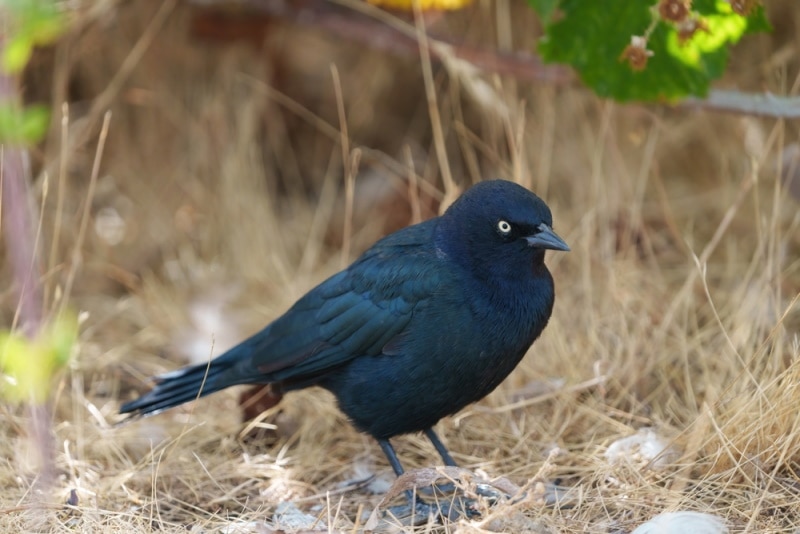
| Scientific Name | Euphagus cyanocephalus |
| Weight | 0.18 pounds |
| Wingspan | 14.6 inches |
| Lifespan | 12 years |
| Diet | Insects, berries, and seeds |
You’ll rarely spot Brewer’s Blackbirds, but they typically reside in colder states such as Montana. These rare-occurring birds were last sighted in 2014, as they hide away in wooded areas, fields, meadows, backyards, parks, marshes, coasts, and grasslands.
They feed on berries, seeds, and insects, but their diet isn’t exclusive. They will feed on anything they find in the garbage.
A Brewer’s Blackbird’s feathers are black and glossy, but you’ll also notice a distinct purple patch and iridescent green glow. You can recognize these birds with their short and shrill songs or unique calls of repetitive ‘chuk’ sounds.
The male Brewer’s Blackbird builds a sturdy base for the nest with the help of twigs and grass, while its female counterpart uses softer materials like mud and dry grass as bedding.
6. Common Grackle
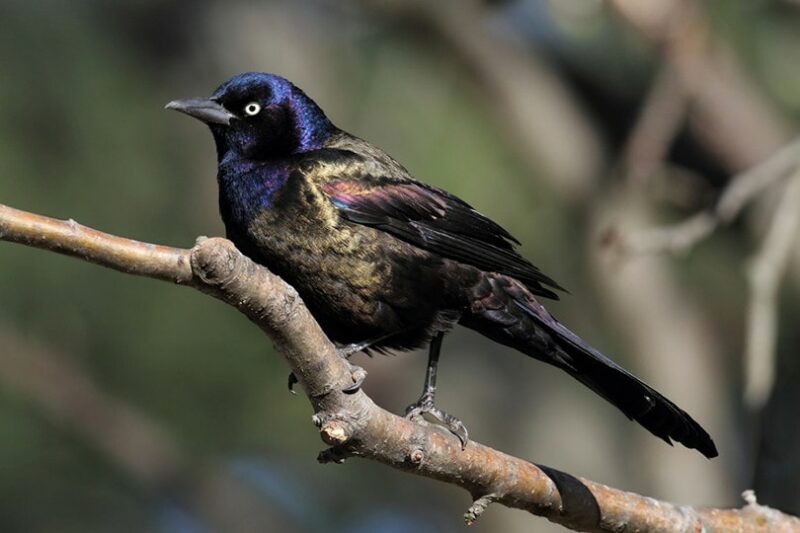
| Scientific Name | Quiscalus quiscula |
| Weight | 0.31 pounds |
| Wingspan | 18.1 inches |
| Lifespan | 22 years |
| Diet | Insects, berries, and seeds |
The Common Grackle is a near-threatened species occasionally spotted in Montana during the breeding season. These birds typically reside in parks, fields, open woodlands, and marshes, unlike most blackbirds which typically prefer densely wooded areas.
Although it’s called the Common Grackle, its appearance is anything but common. It’s covered with glossy, black, and iridescent feathers, which make them easy to spot. You’ll also note a cool blue glow on the iridescent feathers on its head, which appears especially mesmerizing under sunlight.
Common Grackles don’t restrict themselves to their typical diet of seeds, berries, and insects. They also feed on any human food they find while rummaging through garbage.
Their calls include a combination of croaks, squeaks, and whistles.
7. Yellow-headed Blackbird
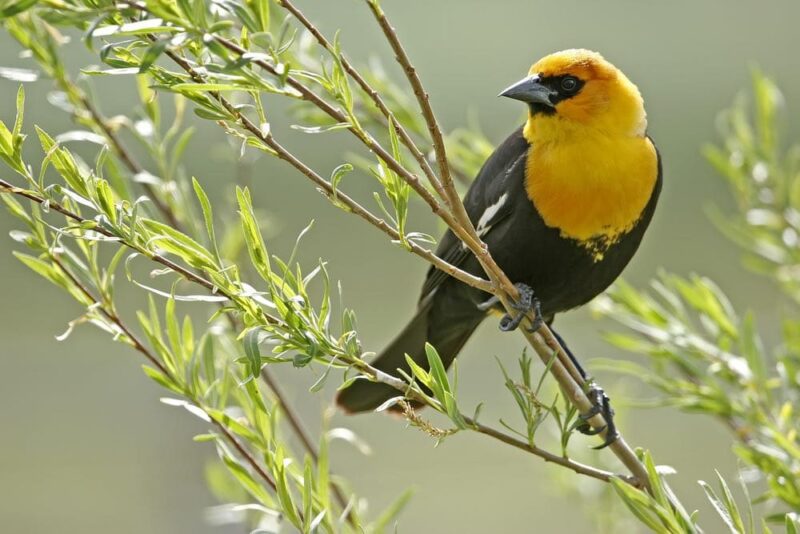
| Scientific Name | Xanthocephalus xanthocephalus |
| Weight | 0.21 pounds |
| Wingspan | 17.3 inches |
| Lifespan | 11 years |
| Diet | Insects and seeds |
The Yellow-headed Blackbird accidentally occurs in Montana’s grasslands, fields, and prairie wetlands. These small birds are covered in glossy black feathers, with the male distinguished by its bright yellow chest and head. The females have brown feathers instead of black.
These birds don’t restrict themselves to any diet, feeding on anything they find in their habitat. That includes insects and seeds. In addition, they have a distinct call, so keep an ear out for chirps followed by a drawn-out screech.
You can use a bird feeder filled with sunflower seeds to attract a Yellow-headed Blackbird to your backyard. However, this is an aggressive species, so approach these birds with caution.
8. Bullock’s Oriole

| Scientific Name | Icterus bullockii |
| Weight | 0.09 pounds |
| Wingspan | 12.2 inches |
| Lifespan | 14 years |
| Diet | Insects, fruit, and nectar |
The Bullock’s Oriole also accidentally occurs in Montana’s parks and open woodlands. Unlike most blackbirds, it doesn’t confine itself to densely wooded areas or wetlands. Its preference for open areas indicates it’s not an aggressive species.
The male Bullock’s Oriole is covered in bright orange, black, and white feathers and has a distinct marking on its head. Meanwhile, the female offers a combination of dull colors such as gray and yellow.
These birds feed on insects, nectar, and fruit. They especially prefer jelly, sugar water, and oranges, which makes it easier to attract them to your backyard for a closer look.
To spot Bullock’s Oriole, keep an ear out for a combination of whistles and cheeps lasting a few seconds.
9. Bobolink

| Scientific Name | Dolichonyx oryzivorus |
| Weight | 0.12 pounds |
| Wingspan | 10.6 inches |
| Lifespan | 6 years |
| Diet | Insects and seeds. |
The appearance of a Bobolink is just as unusual as its appearance. The male Bobolink is covered in black feathers, except for its white stripes and yellow head. Its yellow head resembles blond hair, making this bird easy to spot. On the other hand, its female counterpart offers dull shades of white, black, brown, and green.
They spend their breeding season in the open grasslands of Montana, where you may find them foraging for seeds and insects or perched upon plants.
The male Bobolink exhibits splendid displays to impress the female. Then, the birds nest on the ground, using plant stalks and grass to build the nest. You can identify their calls in irregular patterns with ‘check’ and ‘peek’ sounds.
10. Baltimore Oriole
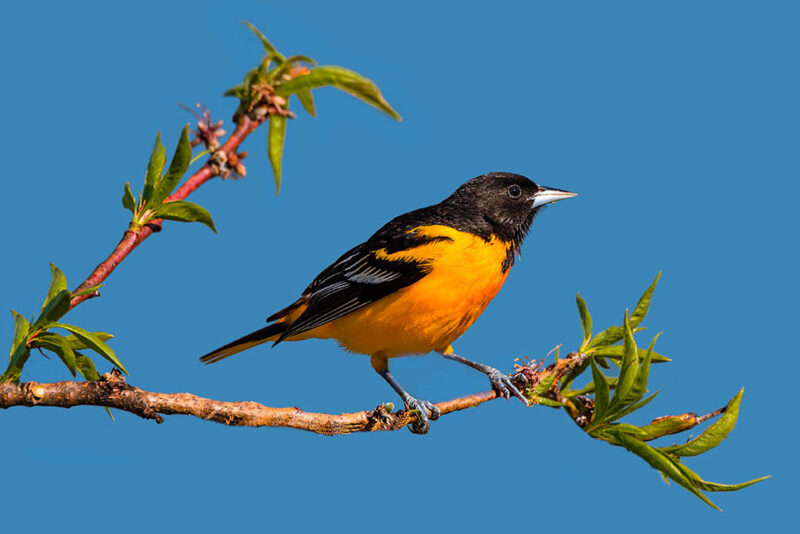
| Scientific Name | Icterus galbula |
| Weight | 0.08 pounds |
| Wingspan | 11.8 inches |
| Lifespan | 14 years |
| Diet | Insects, berries, and nectar |
The appearance of a Baltimore Oriole clearly indicates its diet. It’s covered in bright orange and black feathers, resembling the shades of their favorite food. They mainly eat insects, nectar, and berries but prefer bananas, raspberries, cherries, mulberries, and oranges.
The dull orange and yellow shades of the female Baltimore Oriole aren’t as striking as the male’s appearance. You’ll find these birds in open woodlands, riverbanks, and forest edges, reveling in their solitude.
Those that want a closer look can place sugar water or oranges to attract Baltimore Orioles to their backyard. Also, keep an ear out for flute-like sounds contrasting their shrill alarm calls.
11. Orchard Oriole
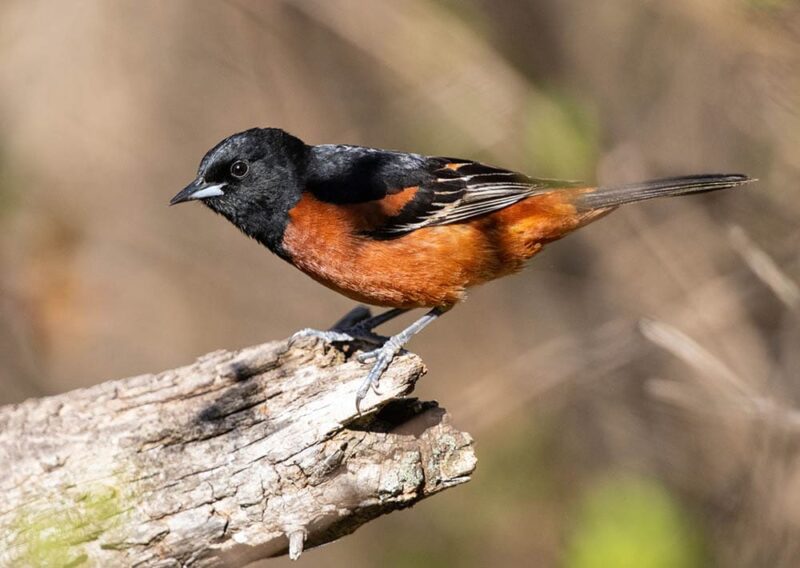
| Scientific Name | Icterus spurius |
| Weight | 0.06 pounds |
| Wingspan | 9.8 inches |
| Lifespan | 10.9 years |
| Diet | Insects, berries, and nectar |
Orchard Orioles spend six months in Montana, from April to November, before migrating to Southern states like Kentucky in the winter. You’ll find these birds in shrublands, riverbanks, backyards, farms, and open woodlands.
These birds are covered in brightly colored feathers, but their heads and backs are black. Its female counterpart has a lime green underbelly.
Orchard Orioles typically feed on nectar, insects, and berries. But, when it comes to insects, they like ants, grasshoppers, beetles, and caterpillars. They feed on nectar from flowers, mulberries, and chalk on good days.
You can recognize them with their irregular and chaotic combinations of whistles, lasting a few moments.
12. Rusty Blackbird
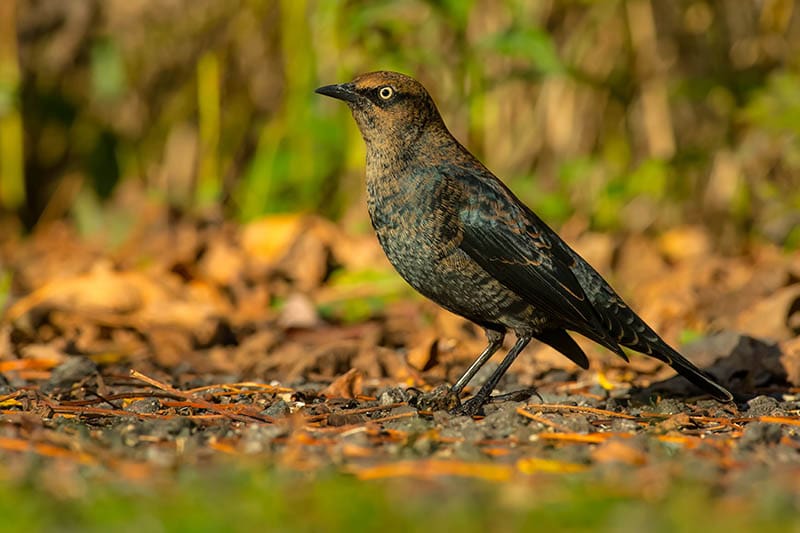
| Scientific Name | Euphagus carolinus |
| Weight | 0.17 pounds |
| Wingspan | 14.6 inches |
| Lifespan | 8 years |
| Diet | Insects and plant matter |
The Rusty Blackbird is a vulnerable species found in the large ponds, swamps, marshes, and bogs of Montana. They prefer spending all year in Northern states due to the cold weather. Rusty Blackbirds typically breed in the boreal forests of Canada before migrating to America for nesting.
They’re covered in plain black feathers with rusty edges that get rustier in colder seasons. The male Rusty Blackbird’s feathers are darker and glossier, while the female has a grayish-brown appearance.
Their diet consists of fish, plant matter, insects, and seeds. Their calls are unique, beginning with a few chirps that end with a high-pitched whistle.
13. Great-tailed Grackle

| Scientific Name | Quiscalus mexicanus |
| Weight | 0.27 pounds |
| Wingspan | 22.8 inches |
| Lifespan | 17 years |
| Diet | Insects, seeds, and grain |
Great-tailed Grackles occur accidentally in Montana, but they’re spotted quite often. They have sharp yellow eyes, long tapered tails, and slender bodies covered in iridescent black feathers. These birds are generally friendly as they like to reside in urban areas alongside humans.
They feed on insects, fruit, seeds, and grains but prefer snails, slugs, bees, spiders, beetles, and worms. If they’re lucky, they may find nestlings, eggs, lizards, and small mammals to feed on. You can recognize them with their rattles, shrieks, and whistles.
14. Hooded Oriole
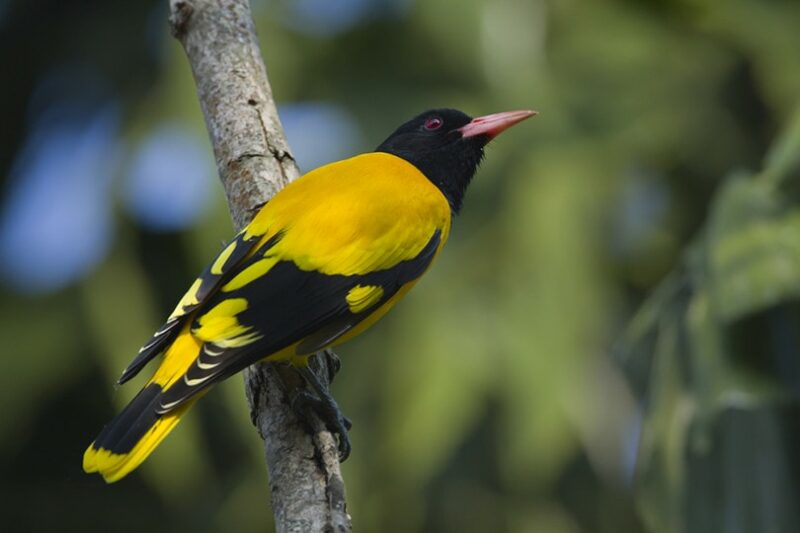
| Scientific Name | Icterus cucullatus |
| Weight | 0.05 pounds |
| Wingspan | 11 inches |
| Lifespan | 5 years |
| Diet | Insects, berries, and nectar |
The Hooded Oriole is another accidental species found in Montana’s open woodlands, riverbanks, and forest edges. However, they’re also extremely rare, as they were last sighted in 2008.
They’re covered in vibrant shades of orange, yellow, and black feathers. You’ll also note a distinct black marking on the male’s face.
Unlike most blackbirds, the Hooded Oriole spends its breeding season in warmer regions such as Mexico and Kentucky. Then, they migrate to colder regions such as Montana and New York. Some Hooded Orioles spend all year in Montana to benefit from the ready supply of food, fruit, and nectar feeders.
15. Eastern Meadowlark

| Scientific Name | Sturnella magna |
| Weight | 0.33 pounds |
| Wingspan | 15.8 inches |
| Lifespan | 5 years |
| Diet | Seeds, waste grain, and insects |
The Eastern Meadowlark is another near-threatened species you may occasionally spot in Montana. They prefer spending their summer in Montana and New York before migrating to Southern states for the winter.
They prefer residing in meadows, prairies, and grasslands, where they eat seeds, insects, and waste. Their bright yellow and black feathers give them a distinct appearance, especially due to the black band across the chest.
The distinct song of an Eastern Meadowlark means spring is just around the corner, so keep an ear out for sharp and rhythmic whistles. Their most impressive feature is that Eastern Meadowlarks can sing over a hundred songs.

Conclusion
Montana is home to various blackbirds that make the most of the chilly region and spend their breeding season in cool weather. You can recognize most of the state’s unique blackbirds by their appearance, sounds, and behavior. These include Great-tailed Grackle, Brown-headed Cowbird, Red-winged Blackbird, Yellow-headed Blackbird, and Rusty Blackbird.
You can enhance your birdwatching skills by attracting these blackbirds to your backyard. But make sure you’re following the precautionary measures, as some of these Montana blackbirds can become really aggressive.
Don’t forget to watch these blackbirds in Montana the next time you visit Montana!
Featured Image Credit: K-nana, Shutterstock
Table of Contents
- The 15 Types of Black Birds in Montana:
- 1. European Starling
- 2. Red-winged Blackbird
- 3. Western Meadowlark
- 4. Brown-headed Cowbird
- 5. Brewer’s Blackbird
- 6. Common Grackle
- 7. Yellow-headed Blackbird
- 8. Bullock’s Oriole
- 9. Bobolink
- 10. Baltimore Oriole
- 11. Orchard Oriole
- 12. Rusty Blackbird
- 13. Great-tailed Grackle
- 14. Hooded Oriole
- 15. Eastern Meadowlark
- Conclusion
About the Author Jeff Weishaupt
Jeff is a tech professional by day, writer, and amateur photographer by night. He's had the privilege of leading software teams for startups to the Fortune 100 over the past two decades. He currently works in the data privacy space. Jeff's amateur photography interests started in 2008 when he got his first DSLR camera, the Canon Rebel. Since then, he's taken tens of thousands of photos. His favorite handheld camera these days is his Google Pixel 6 XL. He loves taking photos of nature and his kids. In 2016, he bought his first drone, the Mavic Pro. Taking photos from the air is an amazing perspective, and he loves to take his drone while traveling.
Related Articles:
Monocular vs Telescope: Differences Explained (With Pictures)
10 Types of Hummingbirds in Arkansas (With Pictures)
8 Types of Hummingbirds in Nebraska (With Pictures)
5 Types of Hummingbirds in Idaho (With Pictures)
3 Types of Hummingbirds in Mississippi (With Pictures)
8 Types of Hummingbirds in Kansas (With Pictures)
5 Types of Hummingbirds in West Virginia (With Pictures)
5 Types of Hummingbirds in Ohio (With Pictures)
